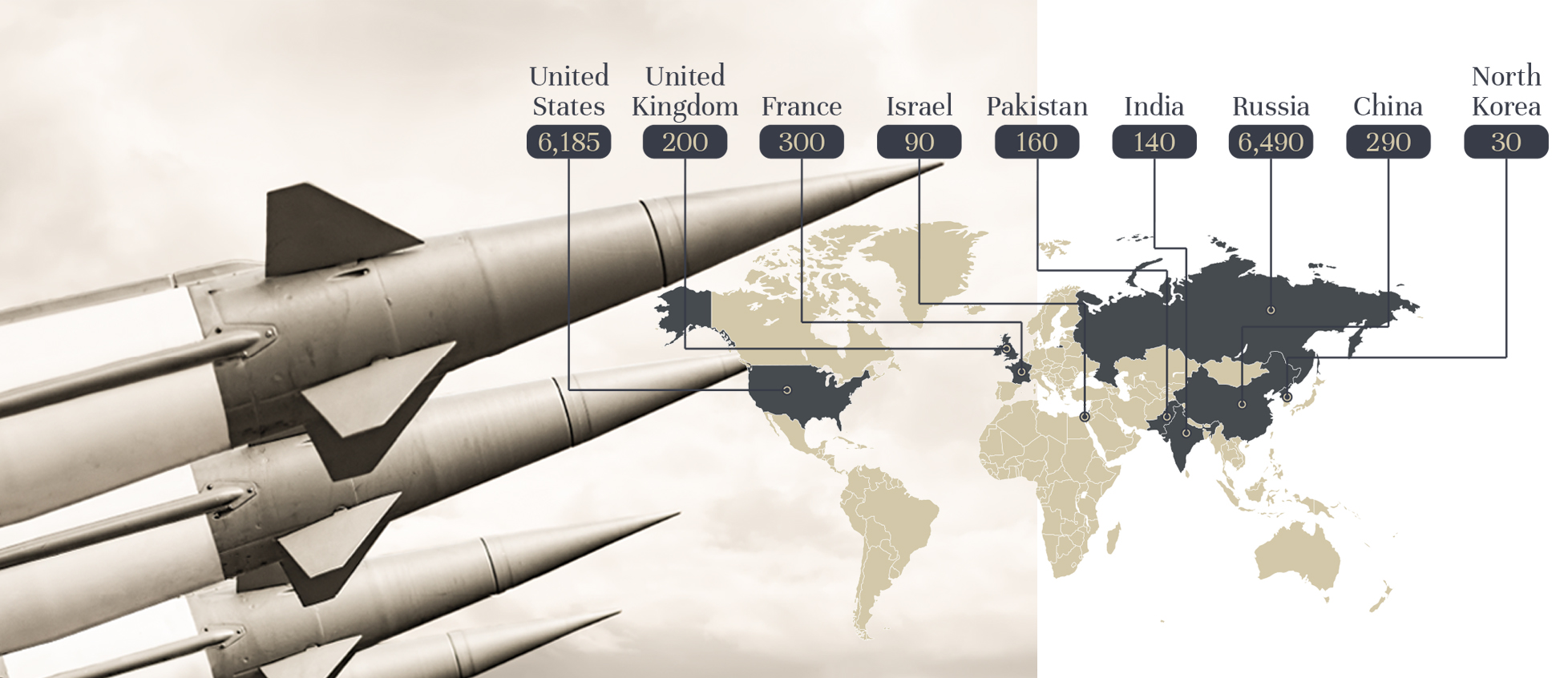Introduction
With the future in such a state of uncertainty and political relationships more strained than ever, there is one silent threat that could end up being more deadly and dangerous to humanity than a hundred pandemics: nuclear weapons.
In 1945, the US bombed Hiroshima and Nagasaki, effectively ending World War II and killing well over 100,000 people, the majority of whom were civilians. The bombing of Nagasaki was the second and final time a country deployed a nuclear weapon in combat. However, it wasn’t the last nuclear explosion, as testing of controlled explosions continued for years.
 [left] The Trinity explosion; [right] Wrecked framework of the Museum of Science and Industry in Hiroshima, Japan 1945 © Everett Collection
[left] The Trinity explosion; [right] Wrecked framework of the Museum of Science and Industry in Hiroshima, Japan 1945 © Everett Collection
On the 75th anniversary of the bombing, Nagasaki Mayor Tomihisa Taue called on Japanese President Shinzo Abe and the central government to sign and ratify the 2017 United Nations Treaty on the Prohibition of Nuclear Weapons. However, there has been little if any official progress towards an international ban on nuclear weapons since then.
 Data from: Arms Control Association Source: Hans M. Kristensen, Matt Kordas, U.S. Department of State, and Stockholm International Peace Research Institute.
Data from: Arms Control Association Source: Hans M. Kristensen, Matt Kordas, U.S. Department of State, and Stockholm International Peace Research Institute.
We support the call for a ban on nuclear weapons, and as the threat of nuclear bombs remains ever present, we are continuing our annual architecture competition to create “The Last Nuclear Bomb Memorial.” The Last Nuclear Bomb Memorial / Edition #6 is the sixth annual competition in which participants are tasked with designing a memorial located within a decommissioned nuclear weapons testing site. In response to the global silence surrounding the issue of nuclear weapons, participants in “The Last Nuclear Bomb Memorial / Edition #6” must submit their designs with no description text. Architectural ideas must be communicated strictly through visuals. We are asking participants to design a building or structure where the architecture speaks for itself.

The Last Nuclear Bomb Memorial / Edition #6 competition must submit their designs with NO DESCRIPTION TEXT; Choose a site from the list (available for download below) of top testing sites for the world’s strongest nuclear weapons.
Download the full competition brief for more information!
Competition is open to all. No professional qualification is required. Design proposals can be developed individually or by teams (4 team members maximum). Correspondence with organizers must be conducted in English; All information submitted by participants must be in English.
Brief
The full competition brief can be downloaded as often as required; no additional information will be provided after registration.
Full Competition Brief



Prizes
10,000 €
5,000 €
3,000 €
1,000 €
6 Honourable mentions & certificates
Buildner will acknowledge the outstanding performance of all winners and honourable mentions with Certificates of Achievement.
Publicity campaign
Buildner's publicity campaign offers extensive exposure to the architectural community, ensuring that the results of the competition are seen by a vast audience:
Buildner's two million
The results are published on buildner.com, a leading website in the architecture industry, attracting over one million unique visitors annually. Additionally, the campaign extends to Buildner's social networks, which boast over 800,000 followers combined, and through newsletter campaigns reaching over 200,000 subscribers.

Interview and movie
Winners will have the opportunity to submit a movie and an interview, boosting their recognizability and helping to build their name in the industry.

Extensive media network
Buildner leverages an extensive network of media industry leaders to publish the competition results. This broadens the audience further, ensuring that participants' work is showcased across multiple platforms known for their influence and reach in the architecture and design sectors.
Jury
Jury members shall under no circumstances be contacted by competition participants or their representatives. Participants who attempt to contact jury members, shall be disqualified.
All jury members are involved in the evaluation based on their availability at that time. All communication regarding the competition should only be carried out with Buildner staff. For any questions please contact us on [email protected]
Key dates
Send reminders13 November 2025
19 November 2025
In order to guarantee equal opportunities to all competition participants.
No new questions will be answered after this deadline.
15 December 2025
10 February 2026
19 November 2025
In order to guarantee equal opportunities to all competition participants.
No new questions will be answered after this deadline.
Why would you want to enter an architecture competition?
Learn – Gain real world experience
Create – Explore bold architectural ideas
Show – Earn global recognition
Connect – Open doors to new clients

Why Buildner?
The world’s leading architecture competition organiser!
15
years of experience













